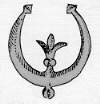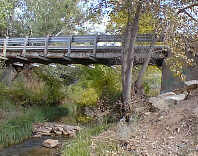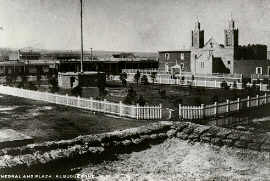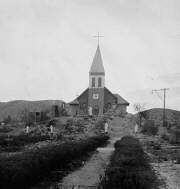Following the conquest of Mexico, Spanish explorers moved north into what is now New Mexico. Francisco Vasques de Coronado led the first expedition into the Rio Grande Valley in 1540. Expeditions led by Francisco Sanchez Chumascado and Antonio de Espejo followed in 1581 and 1582. Permission to establish the first Spanish colony was given to Don Juan de Oñate, and in 1598 he brought the first colonists to San Gabriel (near present-day San Juan Pueblo). The provincial headquarters were moved to Santa Fe in 1610. In 1680, the Pueblo Indians revolted against the Spaniards and temporarily drove them from New Mexico. Don Antonio de Otermin attempted reconquest in the 1680s, but it was not until 1693 that Don Diego de Vargas retook Santa Fe. The Spanish system of government was established in New Mexico between 1693 and 1821. New Mexico became part of the Republic of Mexico in 1821 and officially part of the United States in 1846.
Thus it is no accident that life in New Mexico reflects Spanish heritage to a greater extent than the English heritage characteristic of the eastern part of the country, since Spanish culture was dominant for a longer period of time. It is no wonder that enthusiasm for the United States Bicentennial in New Mexico was not overwhelming, since many people of Hispanic descent could trace the New World history of their families back more than 300 years.
 |
"NAJA"
|
In order to understand the character of New Mexico during the period of Spanish domination, it is necessary to understand the civil and religious policies of Spain with respect to its colonies, as well as the cultural heritage of the Spaniards themselves. In the sixteenth century, Spain had only recently driven out the Moors, and in many ways, Spanish culture was a blend of Moorish and European elements. This blend, reflected in part in the Spanish language, was imported to Spanish colonies. Thus, the term adobe is derived from an Arabic verb meaning "to conserve." The traditional Southwestern "squash blossom" necklace is a copy of the pomegranate flower, which the Moors introduced to Spain, and which was frequently depicted on saddles. In parts of New Mexico, the doors of houses were painted blue, a traditional Arab way of warding off the "evil eye."
Colonial Spanish society was dominated by a caste system. At the top of the hierarchy were people who had been born in Spain (sometimes called Gauchupines). Most administrative officials belonged to this group. The Creoles were people of pure Spanish descent who had been born in the Americas. Creoles did not occupy the top administrative posts, but they dominated the Catholic church and political bureaucracies, owned land and mines, and were often encomenderos. (Under the encomienda system, the Spanish government gave rights to Indian labor to its colonists. Land was not part of the encomienda. Encomienda labor might be used for agricultural work or personal service to the encomendero.) Below the Creoles were mestizos, people of mixed Indian, European, and often Negro descent. Mestizos were considered racially inferior, and although "free," they were usually without power. In Mexico, the system was so elaborate that 16 classes of mestizos were distinguished. New Mexico, being on the fringe of things, had a more simplified system. Indians were to be brought into the church and, in theory, should not have been slaves. African blacks were imported and used as slaves in Mexico. In addition, in New Mexico, "barbarous Indians" (those nomadic tribes who had not been baptized) were also enslaved.
In terms of government, the Spanish system was not at all democratic. Power was in the hands of European-born Spaniards and the Creoles. The only democratic institution was the town council. Each village had its council of elder officials who were responsible largely for internal matters. Most of the Spanish colonists in New Mexico were Creoles or mestizos. In addition, there was a class of people referred to as Genizaros, and membership in this class provided a minimal form of upward mobility for Indians and low-class mestizos.
 Genizaros
served as military personnel, protecting colonists and Pueblo Indians from attacks
by nomadic Indians, who had, by this time, acquired the horse and were thus
a real threat. Some Genizaros were captive "barbarous Indians," some
were Pueblo Indians, and some were low-class mestizos. As reward for their military
service, Genizaros were given land and homes in barrios within Spanish
settlements or were given land to form their own Hispanic communities. The Genizaro
communities were often strategically placed to protect Spanish colonial administrative
centers. Thus the village of Carnue in Tijeras Canyon was a Genizaro community,
guarding Albuquerque from Comanche raiders coming from the east. Belen was a
Genizaro community guarding Albuquerque from the south. If such communities
were successful and were not destroyed by raiders, the population lived a "Hispanicized"
way of life and considered themselves Spanish.
Genizaros
served as military personnel, protecting colonists and Pueblo Indians from attacks
by nomadic Indians, who had, by this time, acquired the horse and were thus
a real threat. Some Genizaros were captive "barbarous Indians," some
were Pueblo Indians, and some were low-class mestizos. As reward for their military
service, Genizaros were given land and homes in barrios within Spanish
settlements or were given land to form their own Hispanic communities. The Genizaro
communities were often strategically placed to protect Spanish colonial administrative
centers. Thus the village of Carnue in Tijeras Canyon was a Genizaro community,
guarding Albuquerque from Comanche raiders coming from the east. Belen was a
Genizaro community guarding Albuquerque from the south. If such communities
were successful and were not destroyed by raiders, the population lived a "Hispanicized"
way of life and considered themselves Spanish.
The second important arm of Spanish rule was the Catholic church. In New Mexico, the Franciscans were responsible for missionary activity. Both the Franciscan practice of building churches and missions for Indians in Indian settlements and the encomienda system which legally prohibited the encomendero from living on his encomienda meant that Hispanic and Indian communities in New Mexico were spatially distinct.
According to Spanish policy, colonial lands could not compete with Spain in commercial enterprises. Thus, colonials were prohibited from manufacturing wine, olive oil, and other items. Colonies were encouraged to develop mining, in order to supply Spain with silver and gold, and to develop agricultural activities. In New Mexico, mining was widespread, but ranching was the primary economic activity, with trade secondary.
 |
San Felipe de Neri Church
|
Many Hispanic colonists settled in ranches along the Rio Grande between Puaray (now Coronado State Monument) and Isleta before the Pueblo Revolt. The area was referred to as the Rio Abajo, but was not an administrative unit. In 1706, following the reconquest, Don Francisco Cuervo y Valdez, 28th colonial governor, founded an administrative unit or villa which he named San Francisco De Alburquerque in honor of Don Francisco Fernandez de la Cueva Enriquez, Duque de Alburquerque, the 34th viceroy of New Spain, and resident in Mexico City. The viceroy, fearing the displeasure of King Philip V of Spain because the new villa had not been authorized by him, changed the name to San Felipe De Alburquerque, in honor of the king.
(The "r" in the second syllable was later dropped by Anglo-American colonists.) The new villa was founded on the edge of meadows of the Rio Grande at a place where the river could be forded by ox carts and near good pasturage and timber. The original settlement consisted of 12 families who had come from Bernalillo. The original settlement was in what is now Old Town.
The plan of Hispanic settlements like Albuquerque, consisting of a church and buildings arranged around a plaza in a rectangular or square formation, was decided by decree. This arrangement offered protection, a stockade against attacks by nomadic Indians or possibly against another rebellion on the part of the pueblos. The church in Albuquerque, San Felipe de Neri, was built on the north side of the plaza (where it still stands), surrounded by a few public buildings and houses.
The economy of the Hispanos differed slightly from that of their pueblo neighbors. Like the Indians, the Spaniards cultivated corn, beans, and squash. They also introduced new crops--tomatoes and chile from Mexico; wheat, apples, pears, peaches, cantaloupe, watermelons, and grapes from Europe. In addition, they introduced livestock--chickens, sheep, goats, pigs, horses, oxen, and burros. Timber cutting, for building, firewood, and clearing additional agricultural land was rapid, and by 1820 it was necessary for the residents of Albuquerque to haul timber from as far away as 25 miles (40 km.). Sheep thrived in New Mexico, and while weaving became an important activity, ground cover was destroyed in many places by overgrazing, and arroyos became a serious problem.
Hispanic settlers, like their Indian neighbors, used the waters of the Rio Grande for irrigation and seeps and springs in the mountain settlements. The impact of the iron plow, known to the Spaniards, was minimal, for two reasons. First, plows increase productivity most dramatically in areas of heavy soils that cannot be turned by hand, and most desert soils are not that heavy. Second, iron for plows was scarce in colonial New Mexico and too expensive for most settlers. The major impact of Hispanic subsistence activities was the introduction of domestic livestock. The Indians exploited the wild plants and animals of marginal land as food in times when crops failed. The Hispanic farmers grazed sheep on marginal land. Sheep and other domestic animals are an economic advantage in that they are "living storage." In times of crop failure, a farmer can kill his sheep for food. On the other hand, sheep are more expensive food than plants. Being higher on the food chain, more energy is lost in the transfer from sun to plants to sheep to man than in the sun/plant/man chain.
Probably more important is the long-term effect of sheep raising. In desert areas, plants, which bind the soil, are scarce because of the lack of water. Sheep, goats, and cows eat this minimal vegetation, exposing soils to quite rapid erosion. The effects of erosion are not limited to land that is marginal for agriculture. As vegetation is lost, arroyos cut deeper and the water table in many areas may be permanently lowered. Overgrazing allowed by Hispanos, white ranchers, and Indians has had an important, long-term, deleterious effect on the New Mexican landscape.
Domestic animals, particularly burros and oxen, introduced another change as well. The second most important area of the economy was trade. The Hispanics' trade network was not very much larger than the Indians' network. Few goods manufactured in Europe ever reached as far north as central New Mexico. On the other hand, burros and wagons made transport of much larger quantities of goods feasible. Goods traded south from Albuquerque included hides, tallow, surplus sheep and wool, some silver, and grain. In return, goods from Mexico included manufactured items (furniture, cloth, tools) and, when needed, food. The Spaniards did not invest in road construction in New Mexico, and the overland route was long and difficult. It often took longer to travel from Mexico City to Santa Fe by burro than it did to travel from Mexico City to the Philippines by ship.
 |
San Ignacio Church
|
During the Spanish Colonial period, New Mexico seems to have walked an economic tightrope. Hispanic colonists greatly increased the local population. Domestic animals and the increased flow of trade goods improved economics only a little. By 1800, the balance was precarious enough so that the population of individual Indian communities varied in size in response to rainfall patterns. (The same situation may have applied to Hispanic communities, but no one has studied them.) It was also during the Spanish period that raiding by nomadic Indians (Apaches and Comanches in the Albuquerque area) became a real problem. Many of the raiders were themselves displaced by the presence of the French in the Mississippi Valley. The Europeans had also provided horses, which facilitated the raiding activities.
In Hispanic Albuquerque, the church, as well as the family, was an institution responsible for education. The first classrooms were in the parish house of San Felipe de Neri, which started operations as a school in 1770. In 1772, the Catholic fathers asked for and received $600 to establish the first free school in the town. Presumably only the very rich could afford to send their children to Mexico for further education.
Two problems that were to plague Albuquerque for years--waste disposal and flooding--began during the time of Spanish rule. The streets, ditches, and the Rio Grande were generally used for dumping refuse, and citizens complained about unsanitary conditions in the town. Flooding, which was worsened by overgrazing, was a particular problem for people who depended upon moving goods by carts and wagons.
During the Hispanic period, Albuquerque did not seem destined to become the major city that it is now. Throughout the period, Bernalillo and Socorro were of about the same size, and, of course, Santa Fe was the most important center in the state. Whether or not Albuquerque could have lasted a very long time as a growing community under Spanish (and later, Mexican) rule is not known because the development of the town was essentially insured by the opening of the Santa Fe Trail and the migration of Anglos from the East. It would seem that, at least initially, Albuquerque was saved not by importing Anglo technology but by expanding its trade network to include the United States.
(Up to Section III, Back to Pueblo Indian Influence, On to Anglo Influence)